Recent Activity

It is not something I would ever advocate. Peach leaf curl is a fungal disease and bleach is not a fungicide. Moreover, bleach has an extremely high pH (11) and is toxic to all manner of other organisms, including pollinators, as well as being very damaging to plant foliage.
Get a proper fungicide registered for peach leaf curl and apply as directed in fall after leaf drop and again at bud swell in spring and again in 2 week intervals while conditions that encourage the disease persist. Do not spray anything when the tree is in flower.

Covering the trees from rain is natural and it is effective. You'd have to construct a plastic covered frame for each tree. Stuff from the kitchen isn't going to help. There are no remedies for plc, only preventatives.

I forgot to upload the pics. See above please.

Too late to prune now. Wait until next winter.

You can take cuttings from stems, not leaves. You could also repot the old one to refresh the soil.

I'd say it was field mustard, Brassica rapa var. rapa.

Hen and chicks is the common name for a number of unrelated plants. Yours look to be a Sempervivum or the most common plant with that name. And it is not happy being indoors over winter. These are some of the hardiest perennial succulents you could encounter, rated down to a zone 3, so will easily tolerate even an Ohio winter. All they want is as much sunlight as possible and fast draining soil/protection from heavy rainfall.
The extensions you see forming are actually flower stalks.....a bit early but being indoors is probably the cause of that. Once that plant (the hen) flowers, it dies and should be removed but with luck all the little offsets (chicks) will replace it.
It would have been ideal to gradually acclimate it to being outdoors in the sun again. I'd maybe move the pot to an area that gets very bright light but not necessarily direct sunlight for a week or two. I'd also recommend when/if you replant that you use a much shallower pot and a very fast draining cactus potting mix. These plants grow naturally in the cracks of rocks or in very thin, stony soil and too much rich, water retentive soil in too large a pot is not to their liking.
I can't honestly say how well yours will recover. It's hard to consider that the first and last photos are actually of the same plant.

They'll survive much better than the pot will!! They grow in very cold winter climates in virtually no soil or just enough to anchor their roots. Try them in a plastic nursery pot that can withstand the cold and then you can slip the whole works into a more decorative pot during the growing season. Or just plant them in the ground..

They look like Phlox paniculata to me but it is difficult to see detail. Hope your L.c. show up.

Calcium sources *do* tend to increase the pH, but you can still add them in small quantities. Bonemeal is not a great source and is slow. Oystershell meal is great if you can find it. Ground limestone (not dolomite) is OK, but increases pH faster.
The best thing one can do for a soil that tends toward the high side of neutral is to regularly add organic matter, ideally finished compost. It will help with both pH and availablity of calcium. Lots of compost!
Placing amendments ”in the planting furrow” is not going to be effective; the must be incorporated into the the whole area.
I only grew them for a couple of years in a not-acid soil, and the first year production was poor and there was a lot of brown spots. By the second year of ammending the soil with loads of compost the production was good and spots were few.
Others hopefully will chime in with their experience growing potatoes in high pH situations.

It will grow to at least 10' and as much as 15-18' in a mild climate and with adequate water. It is not uncommon to see 16-18 footers in my area. If you want taller, just go with the straight species of English laurel. That will get 20 feet plus but may require frequent (annual) pruning not to get too huge. They are often grown into small to medium sized trees here. And hardy to zone 6.

Prunus laurocerasus ’Otto Leyken’

Yes, I wasn't clear. I was agreeing to it's being Prunus laurocerasus. It might not even be a named cultivar. There's quite a variety of leaf shape in seedling trees.

Most probably Prunus laurocerasus 'Schipkaensis'

Little tricky to tell with only a top down view but looks like a lupine to me. Lupines are strong pollinator attractors and butterflies will certainly visit them.

There are self fruitful pear trees - Bartlett and Comice are a couple of popular varieties but there are others. You will generally get heavier cropping if you do have a pollinator nearby but it is not essential. Bartlett and Comice have been known to produce heavy quantities of parthenocarpic fruit.
I would not want to rely on your neighbor's Bradford pear. They have been banned from sale and cultivation in Ohio as of 2023.

It's not necessarily a named cultivar. Polyanthus are promiscuous and appear in all sorts of colour combinations. Any Polyanthus seed mix could probably throw up similar plants.

What I am trying to say is that it won't necessarily have a cultivar name. It may well be an old type but it might never have been named if it was just a pass along plant. The edging isn't yellow, the petals are not evenly shaped and the markings are too ill defined for it to be one of the gold laced cultivars. Do you recall where it was grown in England? Can you show the picture from the magazine?

Yep, I grow auriculas (but not the really mimsy 'fancies' and none of mine are named cultivars. They may have started out with a cultivar name (mostly for breeders and showers) but these (vegetatively propagated) plants rapidly lose their varietal names in the hurly-burly of estate gardening as they are promiscuous and so easy from seed, There are heaps of named ones in commerce but generally, once released into the wild, it is impossible to maintain any breeding purity...so although there are a few stable varieties of hose-in hose and named doubles, such as 'Lady Greer', calling it a 'red primula' is the most honest and feasible nomenclature. It is an outstandingly pretty plant though.

Unfortunately, there is no one-size-fits-all organic solution for this issue. Coddling moths and apple maggots - the two primary culprits of wormy apples - are difficult to control even by commercial pesticidal means, let alone organically. Pheromone traps, sticky traps and bagging juvenile fruit are the standard control options.
I'd suggest or neighbor visit their local extension office for details. Or at the very least read these helpful fact sheets on the pests, their life cycles and recommended control methods. The first addresses coddling moths, the second, apple maggots.
https://ipm.ucanr.edu/PMG/PESTNOTES/pn7412.html
https://ipm.ucanr.edu/PMG/GARDEN/FRUIT/PESTS/applemaggot.html

While they may be beneficial in other circumstances, I'm not sure wasps will have much effect against the worms that typically infect apples. Both coddling moths and the flies that result in apple maggots lay their eggs either at the blossom end or under the skin surface of the apple and the larvae develop and mature inside the fruits. They are not visible or accessible to any wasps so how predatory or effective any wasps may be to prevent "wormy" apples is up to considerable discussion, if they have any effect at all.

Totem pole cactus are spineless, tall, skinny, heat lovers that could look very nice in your space.
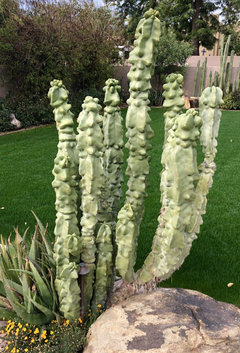

Just a few thoughts. Mexican feather grass is very invasive, it looks pretty when smaller but gets pretty ratty looking later IMO. Bouganvillieas are beautiful but would require a lot of pruning & cleaning up as they are messy , especially in that small of an area. i like the succulent idea or espaliered citrus. i don’t understand the concern about heat for the citrus, they thrive at my Palm Springs home. An alternative to consider would be Calliandra, easily espaliered & soft to the touch, no thorns .

@Jake The Wonderdog thank you for your input and help in this. As you have mentioned, I do have tropical plants a lot of plants that require a very stable ecosystem. I have spent a lot of money on them and in keeping them alive, which is why I tested my water on a less expensive plant that I really don't like...it died. LOL. So, there is absolutely ZERO chance that I will be watering my lawn with it, let alone my indoor plants as some folks suggested.
Honestly, it sounds like I am just going to buckle down and install a reverse osmosis system. That'll be the only way I an ensure that my humidifiers stay in optimum condition and that my plants stay alive.
Thanks everyone!

Hi @ShadyWillowFarm
I'm not sure what system you have, but it sounds like a R/O filter rather than a softener. I'm glad it's working for you.
However, water softeners do not correct pH and they do exchange sodium ions for calcium and magnesium ions. So, if the untreated water is very hard, the softened water will contain much more sodium. And that sodium can build up in the soil over time with indoor plants. How much is too much for plants depends on the plants, and the hardness of the untreated water, how much watering is done, etc.
Again, I appreciate that what you have is working for you - but I don't think it's a water softener.

"I also found that letting tap water sit for a day before using it can help some of the excess sodium to evaporate." Sodium is highly reactive and doesn't exist in nature in its elemental form. The sodium (Na) content in softened water is actually NaCl (sodium chloride), which isn't volatile (doesn't evaporate or gas off). If you dissolve a teaspoon of NaCl in a cup of water, then allow the water to evaporate, you'll have exactly 1 tsp of salt left in the cup; so any reduction in the volume of salted water due to evaporate actually increases the concentration of NaCl in whatever water remains.
That is also why tapwater tends to increase in pH in the summer months. When surface water evaporates it leaves all the dissolved solids it contains behind. The increase in the concentration of (primarily) calcium and magnesium increases the water's pH.
Al

Its really hard to differentiate oaks here.
You might be able to pin it down after a visit to your local botanical garden: https://www.ebparks.org/parks/tilden/botanic-garden

That's a great idea. I work in Berkeley so I'm there most days. I'll stop by the UC Botanical Garden as well. Thank you for your feedback!

Quite possibly bittersweet of some variety.

I've not seen that before. Pretty cool!!
FWIW, English ivy does not produce that effect.

No, Ivy wouldn't do that because it climbs by surface aerial roots. To get the effect it needs to be a spiral twiner.





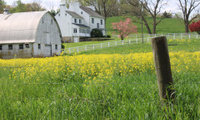
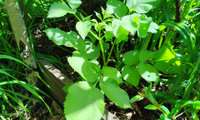

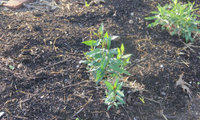
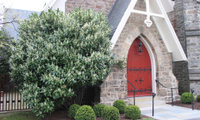
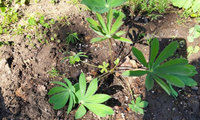
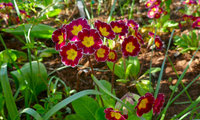
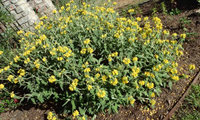
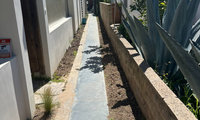

This thing looks so familiar to me, but I can’t recall the trade name.
There is a very active forum for succulents at the garden dot org site. I bet you can get an ID there.
I think it most looks like e. melaco. I'm going to clip off the long stems and propogate them. There are "babies" at the base which can take over.
Thanks for mentioning that other forum. I've not known of it.